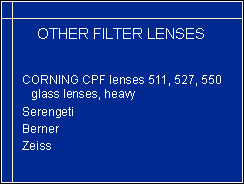Filters
Several retinal disorders cause changes in the function of the retina. The result is often decrease in the speed of adaptation and disturbing photophobia.
Retina has to populations of sensory cells that can catch light energy and convert light energy to chemical and electric changes in nerve cells, which in turn transfer the information to the different parts of the brain.
Rod cells are very sensitive and start to see at luminance levels lower than that at full moon. This is called scotopic vision. Rod cells do not see colours, the world is in different shades of grey. When luminance level increases to the level of twilight, cone cells start to function and we start to perceive colours. This type of vision is called mesopic vision. In day light rod cells' function is inhibited by the cone cells. Daylight vision is called photopic vision.

Rod cells absorb light at a narrow range of spectrum in bluegreen. Since cone cells' absorption maximum are in blue, yellowish green and yellow, it is possible to design filters that specifically absorb light in bluegreen and transmit light in the other areas of spectrum.

These are the well known absorption curves for blue sensitive cones (blue line), green sensitive cones (green line) and red sensitive cones (red line). The black dashed line depicts range of wavelengths where rod absorption occurs.

When retinitis pigmentosa changes involve cone cells in small patches at the site where later ring scotoma will be formed, there may occur so much loss in the relative number of cone cells that the remaining cone cells cannot inhibit the rod cells from functioning in daylight. Since rod cells are highly sensitive, they are overactivated in daylight, which causes glare and photofobia. Since the cause is too much light to the rod cells, the disturbing part of spectrum is filtered by using specific filters that reduce transmission in the bluegreen part of spectrum.

Filter lenses look like regular sunglasses but they differ from them by absorbing light within a narrow range of spectrum and transmitting within the other areas of spectrum. When bluegreen light is filtered, there is less bluish light to activate the rod cells and to be scattered by minute opalescences in the lens, cornea or vitreous. The disturbing glare disappears and the world is seen without disturbances.

Filter lenses are manufactured with different transmission curves. These curves depict filter curves of Multilens filters.

There are three features of Multilenses. In filters: 1. choice of transmission curve between 400 and 550nm, 2. choice of either lighter or darker polarising surface. There are also photochromatic lenses that become darker in bright light.

This list gives the details that one may choose from.

There are other filter lenses from several manufacturers. This list covers those lenses that are often used in Finland.
